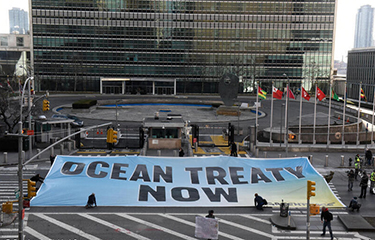Greenpeace is urging members of the United Nations to promptly sign and ratify the High Seas Treaty, also known as the agreement on Biodiversity Beyond National Jurisdiction Ocean Treaty that the U,N, opened for ratification in September 2023.
The treaty seeks to preserve marine life in the world’s high seas – regions that stretch beyond the 200-nautical-mile limits of countries’ exclusive economic zones (EEZs) and comprise 61 percent of the world’s oceans. Greenpeace said quick implementation of the treaty is necessary to achieve the “30x30” goal of protecting 30 percent of the world’s oceans by 2030 that has become a popular benchmark for global leaders, as well as environmental groups and intergovernmental organizations.
In order to ensure that countries’ signatures on the treaty lead to ratification and, subsequently, legal enforcement, Greenpeace published a report titled “30x30: From Global Ocean Treaty to Protection at Sea” outlining specific actions countries can take to establish marine protected areas (MPAs) on the high seas.
“Highly and fully protected areas – ocean sanctuaries – are a proven, cost-effective tool to protect biodiversity, restore depleted populations, and increase resilience to help survive the increasing impacts of climate change, ocean acidification, and pollution,” Greenpeace USA Oceans Campaign Director John Hocevar said. “Given that the high seas cover half the surface of our planet, we cannot meet [the 30x30] commitment without [protecting] the high seas.”
Specific actions that Greenpeace recommended member states take immediately upon signing the treaty include establishing preparatory commissions and drafting key documents such as agendas, rules of procedure, and financial regulations. These proactive measures help mitigate the risk of delays in treaty implementation, it said.
Avoiding delays is crucial because at least 60 countries must ratify the treaty by the U.N. Ocean Conference in June 2025 to remain on target in achieving the 30x30 goal, Greenpeace said.
“The ratification process differs for each country but basically involves a national government enshrining it into domestic law,” Hocevar said. “In the United States, for example, the Senate ratifies treaties. Other countries may ratify through parliamentary or executive action.”
Greenpeace’s report also zeroes in on three priority sites that would make for ideal ocean sanctuaries under the treaty due to their biodiversity and the threats they are currently facing from climate change and industrial fishing. These include the Sargasso Sea in the Atlantic Ocean, the Hawaiian-Emperor Seamount chain in the Northwest Pacific Ocean, and the South Tasman Sea/Lord Howe Rise region between Australia and New Zealand.
These MPAs require effective collaboration between national authorities to implement, making it essential for as many countries as possible to sign on.
“Greenpeace is urging countries to sign and ratify the treaty quickly, but while that process is underway, countries should be working together to develop and build support for new MPA proposals,” Hocevar said.
Referencing data from Global Fishing Watch, the Greenpeace report estimated an 8.5 percent increase in industrial fishing hours on the world’s high seas from 2018 to 2022 and a 22.5 percent uptick in areas identified as requiring protection in the 2019 Greenpeace International Report titled “30x30: A Blueprint for Ocean Protection.”
“One advantage of the high seas is that these are areas at least 200 miles from shore, so most of the vessels operating there are large enough to track fairly easily,” Hocevar said. “If vessels are spending a lot of time near the border of high seas MPAs, it is going to attract attention. The treaty creates new mechanisms to enhance cooperation and increase accountability.”
Longline fishing vessels accounted for 75 percent of total fishing activity, which also raises concerns about a possible increase in bycatch rates, according to Greenpeace. Additionally, there have been record-breaking ocean temperatures, a surge in shipping rates resulting in frequent oil spills, and heightened noise pollution in 2023. All of these factors point toward the necessity for this treaty and its widespread ratification, according to Greenpeace.
“Unsustainable fishing pressure has made it more difficult for many fisheries to remain profitable, leading them to expand farther offshore. Industrialized fleets now operate in every ocean – from the Arctic Ocean to the Southern Ocean – often fishing over a mile deep,” Hocevar said. “For many fisheries, catching the same amount of fish takes more time, energy, and money than it did a decade or two ago. A network of protected areas can create a buffer against uncertainty, which is more important than ever due to climate change.”
Photo courtesy of Stephanie Keith/Greenpeace







